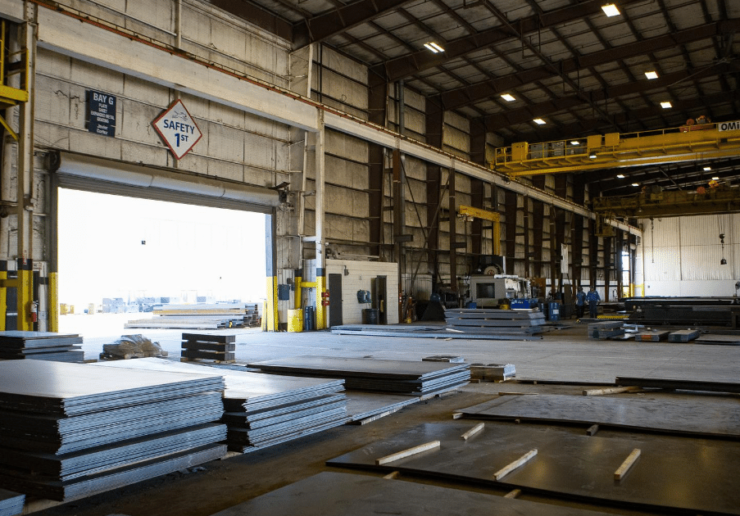Kloeckner Metals specializes in alloy quenched and tempered steel and routinely supplies it in a variety of grades and thicknesses alongside custom processing capabilities.

A514 is also known as T-1 steel and offers high strength with weldable, machinable properties. A514 steel plate is typically used as a structural steel in cranes or large heavy-load machines. This steel plate is suitable at low temperatures and is quenched and tempered for increased strength.
A710 alloy quenched steel plate is a low-carbon, high-yield steel grade. This plate goes through the age-hardening process, also known as precipitation hardening, to increase the tensile and yield strength, enhance toughness, and improve machinability. Some typical applications are construction equipment, rail cars, piping components, truck frames and, shipbuilding.
A514 is also known as T-1 steel and offers high strength with weldable, machinable properties. A514 steel plate is typically used as a structural steel in cranes or large heavy-load machines. This steel plate is suitable at low temperatures and is quenched and tempered for increased strength.
A710 alloy quenched steel plate is a low-carbon, high-yield steel grade. This plate goes through the age-hardening process, also known as precipitation hardening, to increase the tensile and yield strength, enhance toughness, and improve machinability. Some typical applications are construction equipment, rail cars, piping components, truck frames and, shipbuilding.
Alloy quenched and tempered steel plate—often shortened to Q&T steel plate—is created when steel needs additional processing to hold up to severe impact and abrasion. The two-stage process involves first heating the steel plate to an extremely high temperature and quenching it, or rapid cooling with water, followed by reheating the steel plate to a below-critical temperature and then cooling it at normal air temperature. The end result is both increased hardness and strength.
ANSWER:
Quenching is done to rapidly bring metal back to room temperature after it has undergone a heat treatment. Otherwise, the cooling process itself may dramatically change the metal’s structure and properties. Metalworkers usually quench hot metal by placing it into a liquid, but sometimes they will also quench with forced air.
ANSWER:
While quenching or quench hardening means heating the material and then rapidly cooling it to set its structure and properties, tempering is done by heating the quenched material to below the critical point for a pre-determined period of time, and then letting it cool in still air.
ANSWER:
While hardening makes metal more rigid, and brittle, tempering reduces hardness in exchange for increased toughness. Tempering relieves internal stresses and reduces brittleness while improving ductility and toughness.
ANSWER:
Annealing involves the heating of steel to a set temperature and then, as opposed to quenching’s rapid cooling, cooling at a very slow and controlled rate. In comparison, tempering involves heating the plate to a set temperature below the critical point and is usually done in either air, vacuum or inert atmospheres.
ANSWER:
Tempering is usually performed after quenching to reduce the hardness of metal, giving up some yield and tensile strength in exchange for an increase in elasticity and ductility.
ANSWER:
Quenching is done to rapidly bring metal back to room temperature after it has undergone a heat treatment. Otherwise, the cooling process itself may dramatically change the metal’s structure and properties. Metalworkers usually quench hot metal by placing it into a liquid, but sometimes they will also quench with forced air.
ANSWER:
While quenching or quench hardening means heating the material and then rapidly cooling it to set its structure and properties, tempering is done by heating the quenched material to below the critical point for a pre-determined period of time, and then letting it cool in still air.
ANSWER:
While hardening makes metal more rigid, and brittle, tempering reduces hardness in exchange for increased toughness. Tempering relieves internal stresses and reduces brittleness while improving ductility and toughness.
ANSWER:
Annealing involves the heating of steel to a set temperature and then, as opposed to quenching’s rapid cooling, cooling at a very slow and controlled rate. In comparison, tempering involves heating the plate to a set temperature below the critical point and is usually done in either air, vacuum or inert atmospheres.
ANSWER:
Tempering is usually performed after quenching to reduce the hardness of metal, giving up some yield and tensile strength in exchange for an increase in elasticity and ductility.
Between our global footprint, international transportation network,...

X
The Kloeckner Metals website uses modern technologies. Unfortunately, your browser doesn't support those technologies.
Download the latest version of one of these browsers to experience the site: